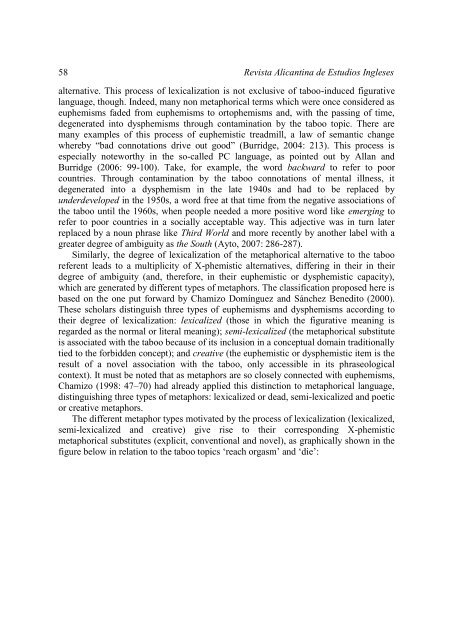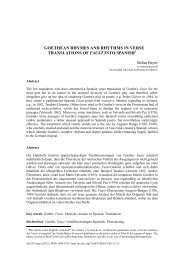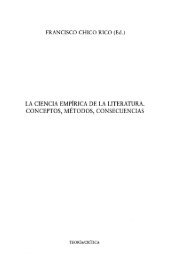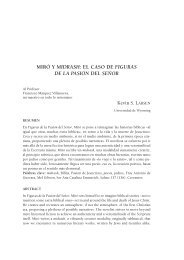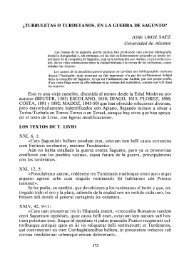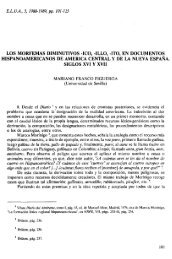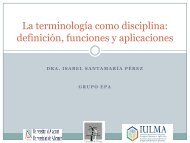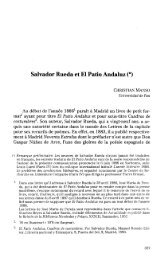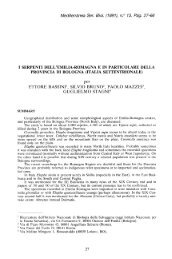Conceptual Metaphors in Taboo-Induced Lexical Variation
Conceptual Metaphors in Taboo-Induced Lexical Variation
Conceptual Metaphors in Taboo-Induced Lexical Variation
You also want an ePaper? Increase the reach of your titles
YUMPU automatically turns print PDFs into web optimized ePapers that Google loves.
58 Revista Alicant<strong>in</strong>a de Estudios Ingleses<br />
alternative. This process of lexicalization is not exclusive of taboo-<strong>in</strong>duced figurative<br />
language, though. Indeed, many non metaphorical terms which were once considered as<br />
euphemisms faded from euphemisms to ortophemisms and, with the pass<strong>in</strong>g of time,<br />
degenerated <strong>in</strong>to dysphemisms through contam<strong>in</strong>ation by the taboo topic. There are<br />
many examples of this process of euphemistic treadmill, a law of semantic change<br />
whereby “bad connotations drive out good” (Burridge, 2004: 213). This process is<br />
especially noteworthy <strong>in</strong> the so-called PC language, as po<strong>in</strong>ted out by Allan and<br />
Burridge (2006: 99-100). Take, for example, the word backward to refer to poor<br />
countries. Through contam<strong>in</strong>ation by the taboo connotations of mental illness, it<br />
degenerated <strong>in</strong>to a dysphemism <strong>in</strong> the late 1940s and had to be replaced by<br />
underdeveloped <strong>in</strong> the 1950s, a word free at that time from the negative associations of<br />
the taboo until the 1960s, when people needed a more positive word like emerg<strong>in</strong>g to<br />
refer to poor countries <strong>in</strong> a socially acceptable way. This adjective was <strong>in</strong> turn later<br />
replaced by a noun phrase like Third World and more recently by another label with a<br />
greater degree of ambiguity as the South (Ayto, 2007: 286-287).<br />
Similarly, the degree of lexicalization of the metaphorical alternative to the taboo<br />
referent leads to a multiplicity of X-phemistic alternatives, differ<strong>in</strong>g <strong>in</strong> their <strong>in</strong> their<br />
degree of ambiguity (and, therefore, <strong>in</strong> their euphemistic or dysphemistic capacity),<br />
which are generated by different types of metaphors. The classification proposed here is<br />
based on the one put forward by Chamizo Domínguez and Sánchez Benedito (2000).<br />
These scholars dist<strong>in</strong>guish three types of euphemisms and dysphemisms accord<strong>in</strong>g to<br />
their degree of lexicalization: lexicalized (those <strong>in</strong> which the figurative mean<strong>in</strong>g is<br />
regarded as the normal or literal mean<strong>in</strong>g); semi-lexicalized (the metaphorical substitute<br />
is associated with the taboo because of its <strong>in</strong>clusion <strong>in</strong> a conceptual doma<strong>in</strong> traditionally<br />
tied to the forbidden concept); and creative (the euphemistic or dysphemistic item is the<br />
result of a novel association with the taboo, only accessible <strong>in</strong> its phraseological<br />
context). It must be noted that as metaphors are so closely connected with euphemisms,<br />
Chamizo (1998: 47–70) had already applied this dist<strong>in</strong>ction to metaphorical language,<br />
dist<strong>in</strong>guish<strong>in</strong>g three types of metaphors: lexicalized or dead, semi-lexicalized and poetic<br />
or creative metaphors.<br />
The different metaphor types motivated by the process of lexicalization (lexicalized,<br />
semi-lexicalized and creative) give rise to their correspond<strong>in</strong>g X-phemistic<br />
metaphorical substitutes (explicit, conventional and novel), as graphically shown <strong>in</strong> the<br />
figure below <strong>in</strong> relation to the taboo topics ‘reach orgasm’ and ‘die’:


